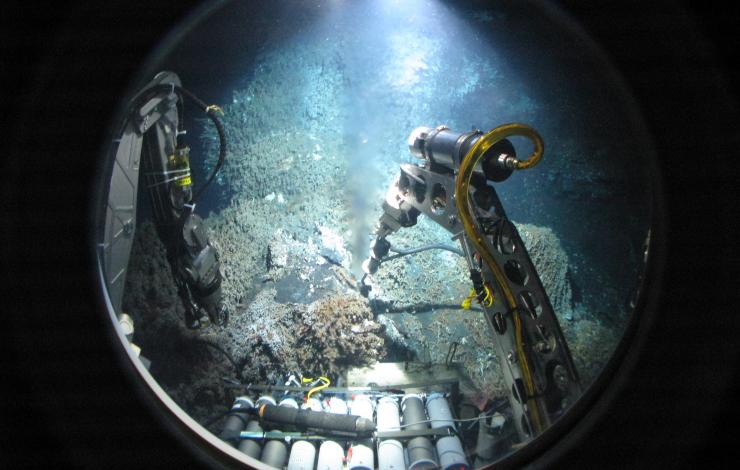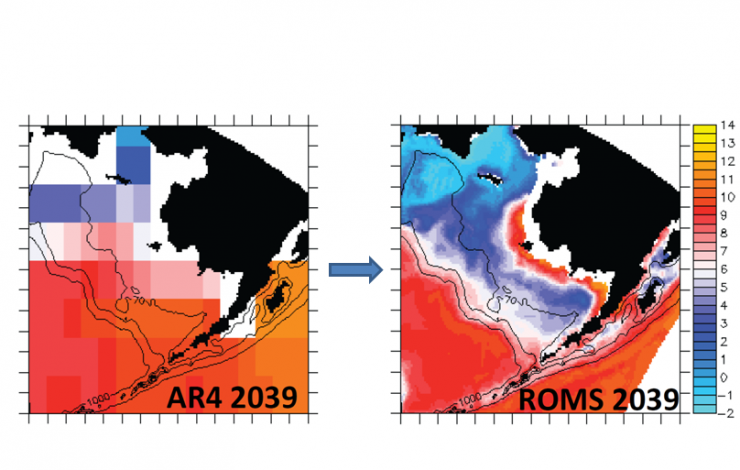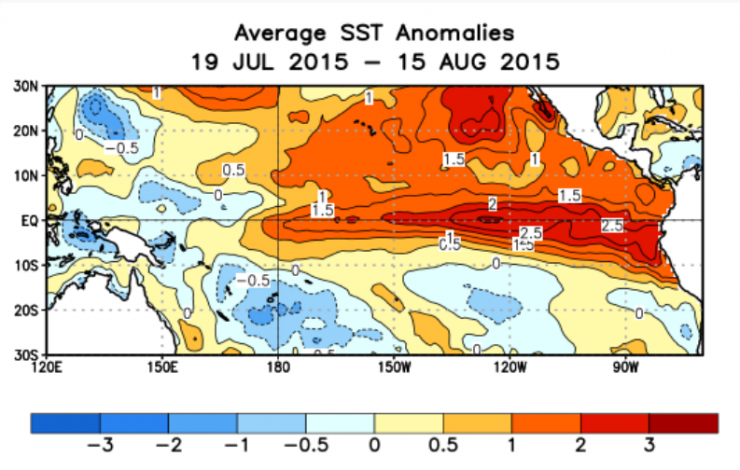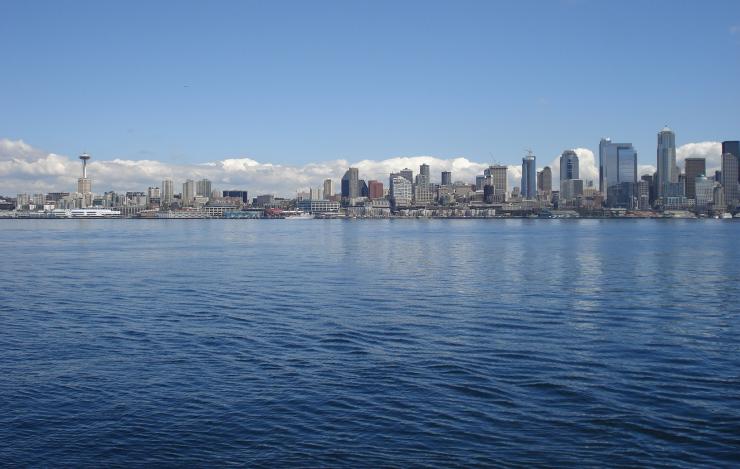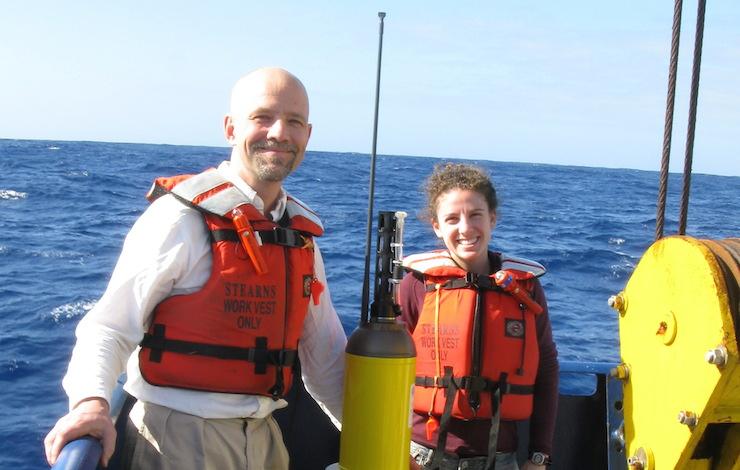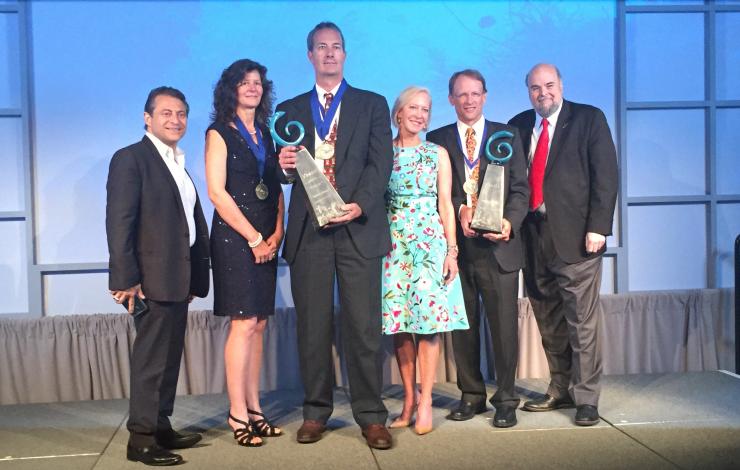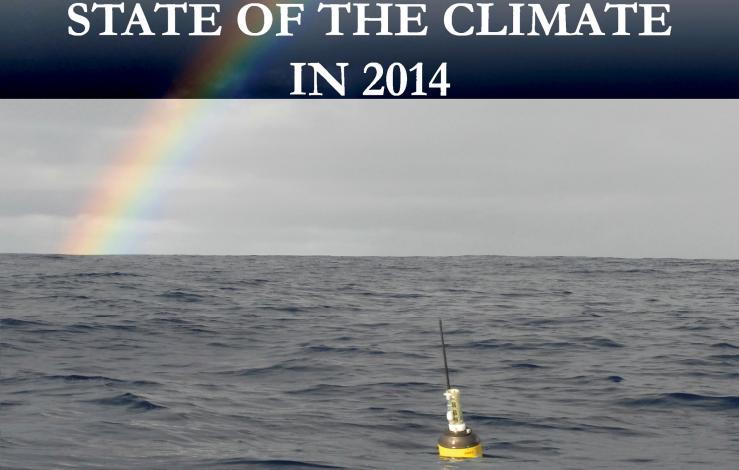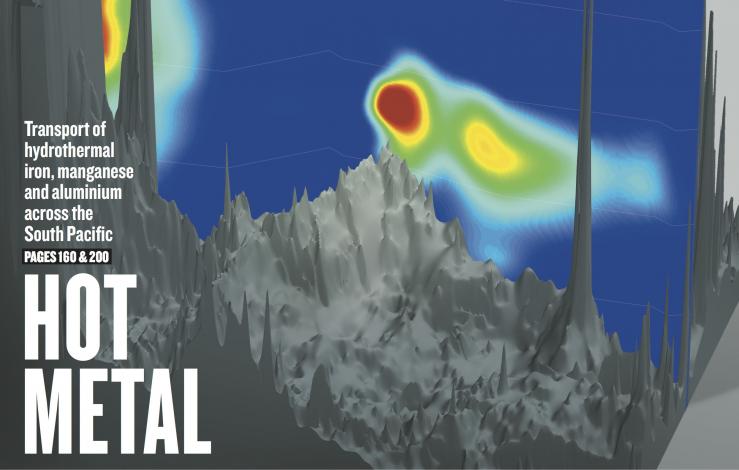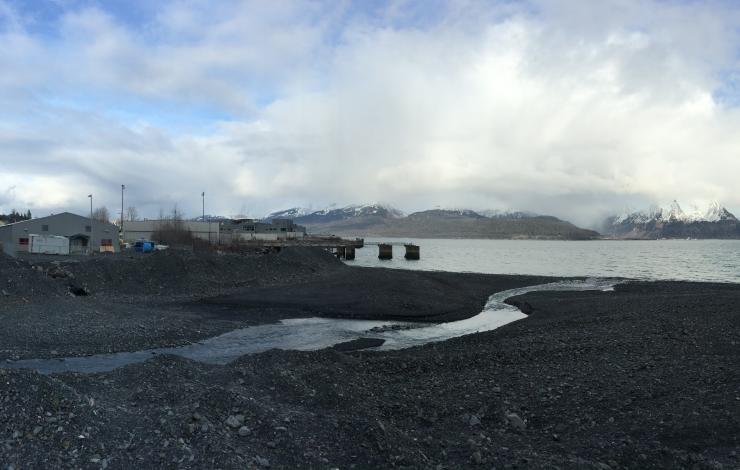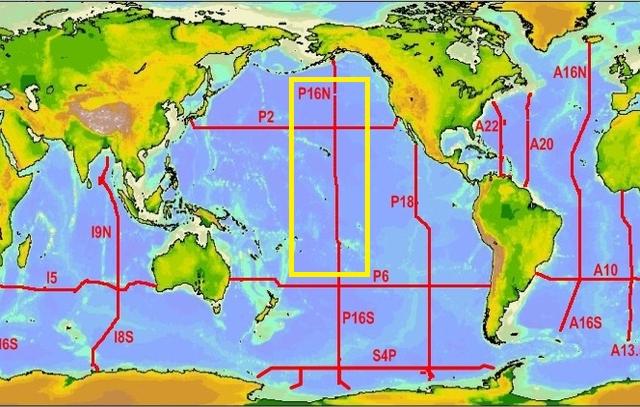What's New Archive
A paper just published in Nature Geoscience shows a newly recognized role for hydrothermal vents in the global carbon cycle. This new research, by PMEL/JISAO researcher David Butterfield and colleagues, shows that hydrothermal vents may act as a recycling and decomposition system for dissolved organic carbon (DOC), an important constituent of the global carbon pool. The scientists found that high temperatures, like those found at hydrothermal vents, can effectively remove DOC not broken down by other processes, like microbial or sedimentary degradation. The implication for the global carbon cycle is that hydrothermal vents act as the ocean’s ‘pressure cooker’, breaking down and removing unreactive and old carbon that would otherwise persist indefinitely.
Read more about PMEL’s Earth-Ocean Interactions Program or the article in Nature Geoscience.
Al Hermann and Wei Cheng, PMEL/JISAO researchers with EcoFOCI are part of a new NOAA-funded study to project large-scale environmental changes in the US Arctic through the process of dynamical downscaling. This process uses the most recent set of global climate models (CMIP5) to simulate regional events in the Bering Sea. Paired with upper trophic level and management models, the project will provide a variety of projections of the Bering Sea ecosystem with varying fishing and climate scenarios.
The CLIMate project seeks to understand how large-scale changes in the atmosphere and oceans will manifest themselves in the Bering Sea, how such environmental changes will affect commercially important fish and other species, and how management strategies could be beneficially modified in the face of anticipated changes in mean conditions, variability, and the likelihood of extreme events.
For more information, please see news releases by NOAA Fisheries and the University of Washington and find more data products at the Alaska Ocean Observing System.
Research and commentary articles just published online in Nature Climate Change by NOAA/PMEL Senior Scientist Michael McPhaden and collaborators highlights the need for continued study into El Niño causes and effects.
McPhaden’s commentary explores possible reasons why the much anticipated El Niño of 2014 failed to materialize, while an unforeseen strong El Niño is developing now. In the same issue, a review paper by McPhaden and colleagues explores the connection between global warming and El Niño/La Niña events. Model results indicate that extreme El Niño and La Niña events will increase in number and intensity as the climate continues to warm.
Read the commentary and research review on Nature Climate Change and the NOAA Press Release about current El Niño research.
NOAA/PMEL Scientist Dr. Simone Alin and UW/JISAO Scientist Nick Bond took part in media event on July 30 highlighting the unusual conditions found in the Puget Sound in 2015. The Sound has been abnormally warm, fueled by the warm water Blob off the Pacific coast, warm weather and lower than usual river inflow. Scientists note that the timing of warmer waters and lower pH conditions have come earlier this year.
Dr. Alin pointed out “It is tempting to compare conditions this year to our projected future climate in the second half of this century. However, this just represents the temperature part of future climate impact on the oceans. We would also expect a sizeable increase in carbon dioxide in the atmosphere and oceans between 2050 and 2100 compared to now, which would worsen ecosystem conditions considerably relative to what we are seeing with the temperature increase alone.”
Read the press release.
Dr. Sarah Purkey’s doctoral dissertation, “The Abyssal Ocean’s Contributions to the Global Energy and Sea Level Budgets Between the 1990s and 2000s”, was recently chosen to receive the 2015 University of Washington Graduate School’s Distinguished Dissertation Award in the Physical Sciences & Engineering category. Dr. Purkey started her oceanographic career in 2007 as a UW/JISAO research scientist/engineer working at PMEL. She was resident at PMEL for her graduate research, advised by PMEL Oceanographer Dr. Gregory C. Johnson in his capacity as an Affiliate Professor with the School of Oceanography, University of Washington. Dr. Purkey is currently a Postdoctoral Fellow at Columbia University’s Lamont-Doherty Earth Observatory.
The winners of the $2 Million Wendy Schmidt Ocean Health XPRIZE were announced yesterday at an awards ceremony held in New York. Winning first place in both the affordability and accuracy categories, Sunburst Sensors received $1.5 Million in prizes for two different sensor designs. ANB Sensors placed second in affordability, while Team DuraFET won second place in the accuracy category; each team took home $250,000.
During the ceremony, a Foreign Affairs panel addressing technology and policy supporting ocean health was held. The panel, which featured NOAA Chief Scientist Rick Spinrad, Stewart Patrick (Fellow, Council on Foreign Relations), Ghislaine Maxell (Founder, The TerraMar Project), and Sherri Goodman (CEO, Ocean Leadership), was attended by PMEL scientists that served as part of the Validation Team for the Ocean Health XPRIZE competition.
Read more about PMEL’s Carbon Group and their role in the Wendy Schmidt Ocean Health XPRIZE and watch this video about Sunburst Sensors to learn more about the winning team.
The State of the Climate in 2014 report, published in July 2015 as a Bulletin of the American Meteorological Society supplement, highlights records in sea level, ocean heat content, and sea surface temperature, also documenting ocean climate variability including the borderline El Niño, the warm-water “Blob” in the Northeast Pacific, and a transition to the warm phase of the Pacific Decadal Oscillation. The cover features a PMEL Argo float, deployed in September 2007 and still active in July 2015. PMEL scientist Gregory Johnson co-edited the Global Oceans chapter of the report, composing haiku to summarize 2014 ocean variations:
Not quite El Niño, | North Oceans’ fluxes, warmth shift, | dance with weird weather.
and longer-term changes:
Seas warm, ice caps melt, | waters rise, sour, rains shift salt, | unceasing, worldwide.
Several PMEL, JISAO, and JIMAR scientists are section authors.
The results of a recent NSF-funded U.S. GEOTRACES research expedition were published in the latest issue of Nature. In this study, lead author and NOAA/PMEL and University of Washington/JISAO scientist Joseph Resing and colleagues unequivocally demonstrate the importance of submarine hot springs (hydrothermal vents) as a source of iron to the ocean interior. Iron is a trace nutrient that is critical to primary production in the ocean. Until recently, the scientific community thought that iron from hydrothermal vents was quickly removed from seawater near the hot springs, however during the expedition they measured hydrothermal iron more than 4,000 km (roughly the distance across the U.S.) from its source. Observations from the study were placed within a global ocean model, and the results suggest that the iron reaches the surface of the Southern Ocean where it supports phytoplankton growth and the transfer of carbon dioxide from the atmosphere to the deep ocean.
Read more about the Earth-Ocean Interactions program and the press releases from the University of Washington and Nature.
Alaska currently has one shellfish hatchery in the state, but the industry is expected to expand to more than $1 billion in the next 30 years as demand for seafood increases. A new study, published in PLOS ONE, is a collaboration between NOAA/PMEL, the University of Alaska Fairbanks and the Alutiiq Pride Shellfish Hatchery in Seward, AK. This study is the first continuous monitoring of seawater conditions at an Alaska shellfish hatchery and it illustrates the potential vulnerability to ocean acidification in this industry. Under current conditions there is a 5-month window of favorable growing conditions for shellfish each year, but this window will shrink and may ultimately close as early as 2040 as water quality declines due to carbon dioxide. Hatcheries and natural shellfish populations will both be vulnerable to these declining growth conditions.
From April–June 2015, scientists on the NOAA ship Ronald H. Brown are collecting observations of Pacific Ocean water properties and currents from Tahiti to Alaska. This expedition is part of the US GO-SHIP Repeat Hydrography Program, an international effort to measure and observe the changing global ocean every decade. This particular cruise fortuitously crossed the equator during a developing El Niño and shortly after a transition to the warm phase of the Pacific Decadal Oscillation, allowing study of how these climate variations affect ocean conditions such as biological production and heat transport.
Read more about the US GO-SHIP program, leg 1 and leg 2 cruise blogs, the PMEL Carbon Program Repeat Hydrography page, the Large-Scale Ocean Physics page, and the Ocean Tracer group.



